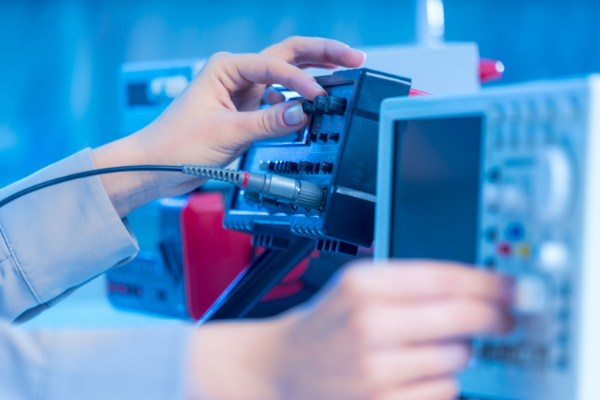• Expansive portfolio of data converter solutions that push the performance envelope
• Delivering outstanding signal integrity, resolution and dynamic range characteristics
• Allowing a new breed of test systems to be developed
There are various arenas in which test instrumentation has dramatically progressed over the course of recent years. We will briefly look at a few examples here.

The roll-out of 5G infrastructure represents a huge engineering effort, far greater than that of previous mobile communication generations. Additional frequency bands are being opened up to accommodate 5G new radio (NR) technology, including mmWave frequencies (+30GHz), with multi-user MIMO and ultra-low latency operation also setting considerable challenges from a test perspective. These challenges will have an impact on both field testing and the compliance testing of networking hardware as it comes off production lines.
Automatic test equipment (ATE) is employed in manufacturing facilities, in order to maximize throughput -eliminating the need for manual intervention, which generally takes more time. As well as optical inspection, comprehensive functional testing will be conducted and this calls for the conversion and conditioning of electrical signals.
Through machine condition monitoring (MCM), the ongoing operational effectiveness of factory production and industrial processing apparatus can be constantly monitored - making it an essential part of the Industry 4.0 era. Leveraging data acquired by arrays of distributed sensors, analysis can be done across the entire operation - thereby enabling benefits like predictive maintenance and procedural optimization to be derived, as well as the identification of potential operational problems before they are exacerbated. MCM is helping companies to increase their productivity levels, as well as reducing operational costs and ensuring worker safety.
In time-of-flight mass-spectrometry, it is possible to identify different ionized particles. This is done by the application of an electric field to accelerate their movement, then measuring the time they take to reach a detector. Such activities create a lot of signal data across a wide dynamic range. This data has to pass through a digitization stage, before it can be scrutinized.
For all of the scenarios detailed here, state-of-the-art signal conditioning components are going to be required - and this is where Teledyne e2v has a great deal of relevant expertise.
Data converter devices, namely analog-to-digital converters (ADCs) and digital-to-analog converters (DACs), enable the translation of real-world data into a form that will allow it to be used in the digital domain, and vice-versa. For items of equipment like oscilloscopes and data logging hardware, the resolution of the ADC and its sampling rate will both be key factors. Conversely, for the DACs used in items like arbitrary waveform generators, it will be attributescharacteristics like the output bandwidth that are most important. Other parameters that need to be looked at when specifying data converters for test-oriented applications will relate to the quality of the data acquired for subsequent analysis. These will include the spurious-free dynamic range (SFDR), the total harmonic distortion (THD), signal-to-noise ratio (SNR) and the bit error rate (BER).
Through continued engineering innovation, Teledyne e2v supplies the foremost manufacturers in the test and measurement sector with game-changing semiconductor devices that assist them in producing instrumentation capable of tackling the test challenges outlined above.
Pivotal in waveforms generators and other types of test equipment, the EV12DD700 is a dual-channel DAC that supports super-high frequency (SHF) direct conversion. Reaching deep into the Ka-band (+30GHz), it has a 12GSamples/s sampling rate and witnesses only minimal attenuation across a broad range of frequencies. Programmable anti-sinc filtering, numerical control oscillator (NCO), direct digital synthesis (DDS) and digital up conversion (DUC) functions are all included.
Exhibiting extraordinary operational flexibility, the EV12AQ600 is a key component in modern oscilloscopes models, as well as MCM, time-of-flight mass-spectrometry and ATE systems. This multi-mode 12-bit resolution quad-channel ADC has very low SFDR figures. An integrated cross point switch permits the allocation of the 6.4GSamples/s sampling capacity across all or just one of its four channels (allowing a rate of 1.6GSamples/s if all four channels are utilized individually or 3.2GSamples/s across two of them).
Exhibiting strong linearity, the devices in the EV12DS130xZP family are well suited to use in high-end applications such as arbitrary waveform generators. These 12-bit DACs have a 3GSamples/s maximum sampling rate and a rise time of just 50ps. Thanks to their integrated 4:1 and 2:1 multiplexing functionality, interfacing with standard LVDS FPGA chips is made very straightforward.
Capable of supporting extremely low latency levels, the EV12DS480 is a 12-bit resolution DAC with a 7.5GHz output bandwidth. The device is able to execute direct digital conversion in the K-band. It has a built-in multiplexer, which can be selected for either 4:1 or 2:1 operation. An exclusive programmable pulse shaping feature is highly beneficial when work is being done across multiple Nyquist zones. The operational modes available are return to zero (RTZ), non-return to zero (NRZ), narrow return to zero (NRTZ) and radio frequency (RF). The external sync function can be used for the synchronization of multiple DAC devices.
The EV10AQ190A is a quad-channel 10-bit resolution ADC device which is targeted at high-speed data acquisition, MCM and ATE applications. It has a 1.25GSamples/s sampling rate per channel and when interleaved can provide 2.5GSamples/s across two channels or 5GSamples/s over a single channel. The number of channels, as well as the gain and the bandwidth, can be adjusted via the SPI interface. A >60dB channel-to-channel isolation prevents any possibility of interference between signals.
Please fill out the form below to contact our sales team about our products and services.